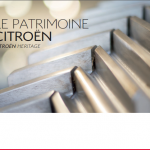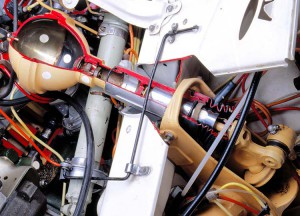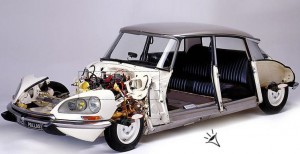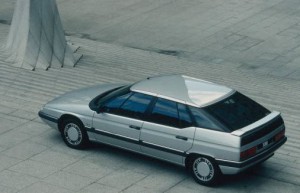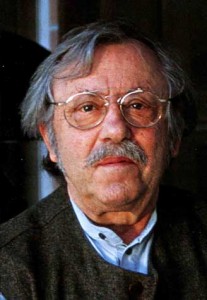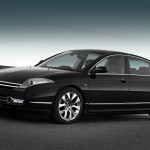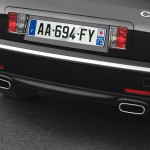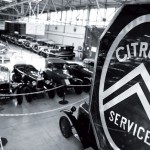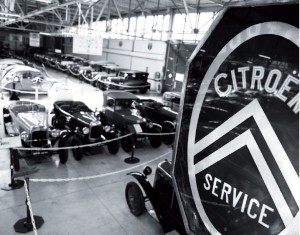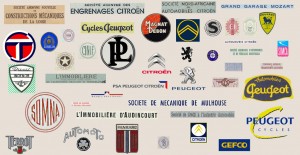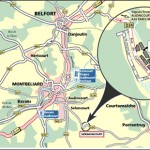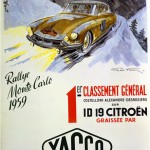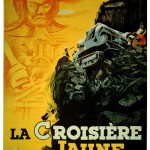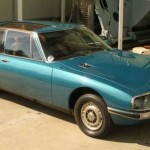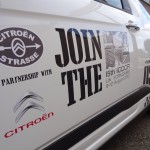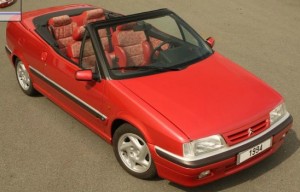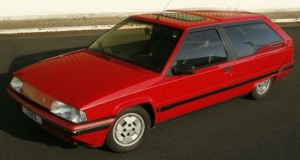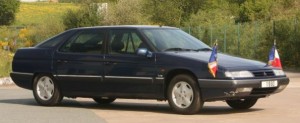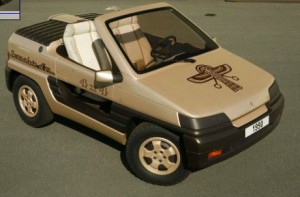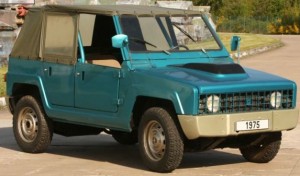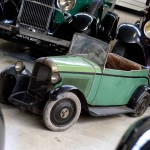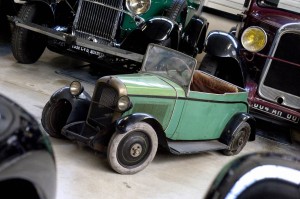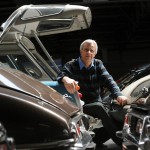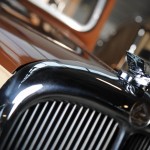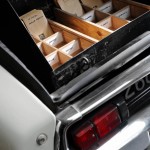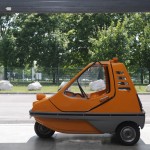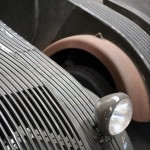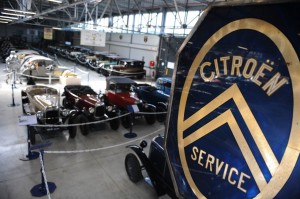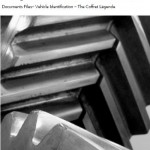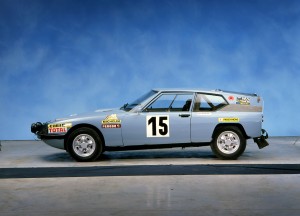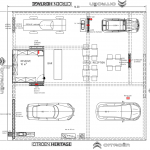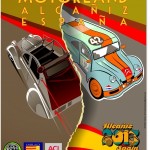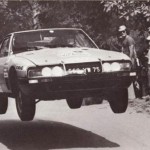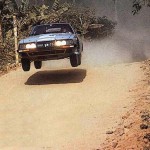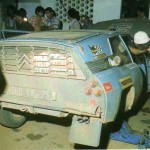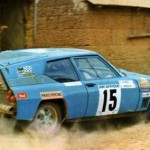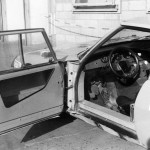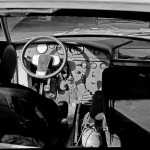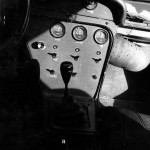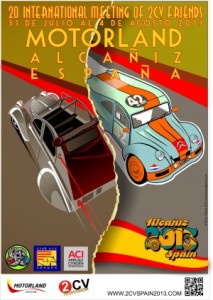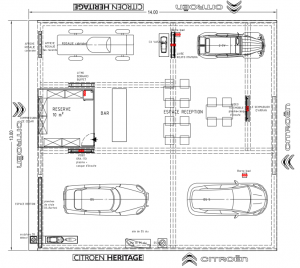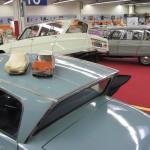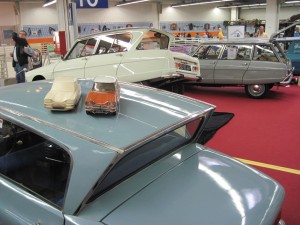Am Sonntag, 7. Oktober 2012 von 10-12h und 14-17h findet die zweite große Versteigerung des Erbes des Unternehmens Heuliez in der Halle 3 auf dem Werksgelände von Heuliez in Cerizay (79) statt; die Objekte können einen Tag zuvor von 10-17h besichtigt werden.
Die Details der Auktion können dem fr. Text im Anhang entnommen werden. Neben einigen Dokumenten und Broschüren, Photos und Devotionalien der Marketing und Kommunikationsabteilung kommen einige Maquettes, gebrauchte Fahrzeuge und Prototypen unter den Hammer, darunter auch der bekannte ECO2000 und ein BX Monospace 7/8 Concept Car von Citroën sowie Heuliez-Amphibienfahrzeuge und Geländewagen. Zwei teilrestaurierte Citroën DS Cabrios, darunter ein 4-türiges, sowie einige Citroën BX (darunter zwei Ambulance) können ersteigert werden.
Die Amicale Citroën hatte bereits umfänglich über die erste Auktion vor einigen Wochen berichtet:
https://amicale-citroen.de/2012/heuliez-prototype-auktion-artcurial/
und bedauert, daß es nicht gelungen war, eine andere Finanzierung für den Erhalt der einzigartigen Pretiosen aus der französischen Automobilgeschichte zu realisieren.
Mit den nunmehr zur Versteigerung anstehenden Objekten scheint der Großteil des Unternehmenserbes nun Geschichte zu sein…
Vielleicht läßt sich ja der ein oder andere neue Eigentümer finden, der seine Pretiosen der Öffentlichkeit bei der ein oder anderen Gelegenheit zur Schau zur Verfügung stellt, sodaß diese nicht für alle Zeiten in privaten Hallen verschwinden – die Technoclassica in Essen wäre sicherlich eine mögliche Präsentation… *wink*
Fotos der zu versteigernden Objekte:
www.interencheres.com
Dank an Dominique Pagneux, den bekannten Historiker und Buchautor zahlreicher Citroën-Literatur, der bei der Katalogisierung und Identifizierung der Heuliez-Objekte und Vorbereitung der Auktion involviert war, für die Bereitstellung dieser Informationen!
—–
The sad story continues: 2nd large sale of the historical heritage of Heuliez
On Sunday, 7 October 2012, between 10-12h and 14-17h the second major auction of the heritage of the famous French manufacturer Heuliez will take place in Hall 3 at the site of Heuliez in Cerizay (79); interested buyers could have a look at the objects the day before between 10-17h.
The details of the auction can be found in the French text section below. Besides some brochures and memorabilia of the Marketing and Communications Department, also used vehicles and prototypes ar being auctioned, including the well-known ECO2000 of Citroën.
The Amicale Citroën had already been extensively reporting on the first auction a few weeks ago (https://amicale-citroen.de/2012/heuliez-prototype-auktion-artcurial/) and regretted that it was not possible to realize a different funding for the preservation of the precious objects from the French automotive history.
Now up for auction with the upcoming objects, most of the companies heritage seems to be history…
Perhaps one or the other new owners could be convinced that their valuables can be shown to the public so that these do not disappear forever in private collections – the Techno Classica in Essen would certainly be a possible presentation context…? *wink*
Find the auction catalogue online:
www.interencheres.com
Thanks to the famous book author and historian Dominique Pagneux who has been involved into classifying the objects and organizing this auction, and for sharing this information with us – and you.
—–
Le deuxième vente aux enchères Conservatoire Heuliez
Le dimanche 7 Octobre 2012 entre 10-12h et 14-17h aura lieu la deuxième vente aux enchères majeur du patrimoine de Heuliez dans le Hall 3 sur le site de Heuliez à Cerizay (79).
Pour es détails de l’enchère, voici le texte au-dessous. En plus des documents et des brochures, des photographies et des souvenirs de la commercialisation et des communications département aussi des maquettes, les véhicules utilisés et prototypes sont sous le marteau, y compris le ECO2000 bien connu et BX Monospace 8.7 concept-car de Citroën, et Heuliez véhicules amphibies et voitures tout terrain. Deux partiellement restauré Citroën DS cabriolets, y compris une 4-portes, ainsi que plusieurs BX dont deux ambulances sont sur la liste.
L’Amicale Citroën avait déjà abondamment de la première vente aux enchères il ya quelques semaines:
https://amicale-citroen.de/2012/heuliez-prototype-auktion-artcurial/
et regrette que ce n’était pas possible de réaliser un financement différent pour la conservation des objets précieux de l’histoire automobile française.
Maintenant en vente aux enchères à venir avec les objets, la plupart du patrimoine de la société semble être l’histoire …
Peut-être l’un ou les autres nouveaux propriétaires peut reflechir d’exposer ses nouveaux objets sur une ou autre occasion pour le public, et nous esperons que ceux-ci ne disparaissent totalement dans les salles privées – la Techno Classica à Essen serait certainement une platform présentation pour elles… parlez avec nous! 🙂
Merci à Dominique Pagneux pour toutes les details!
VENTE HEULIEZ
Dimanche 07 octobre 2012.
Exposition : Samedi 06 octobre, de 10h à 17h.
Vente : Dimanche 07 octobre, de 10h à 12h et de 14 h à 17h.
Hall O3 usine Heuliez.
CERIZAY (79).
Stationnement parking Nord.
Accès rond-point route de Mauléon et boulevard Pompidou.
Restauration sur place de 12h à 14h.
Société de vente :
Commissaire priseur : Jack-Philippe RUELLAN.
Historien conseil chargé de l’organisation de la vente : Dominique PAGNEUX.
Collaborateur associé à l’organisation : Stéphane LE MINIER.
Précisions légales :
– Les véhicules non munis de numéro de frappe à froid ou de plaque constructeurs sont vendus en l’état et pour pièce.
– Les véhicules munis d’un numéro de frappe à froid ou d’une plaque constructeur, mais dont la carte grise a été perdue, seront délivrés avec un certificat de vente et le dossier complet pour demander un duplicata en préfecture.
– Tous les lots sont vendus sans prix de réserve.
– Tous les lots devront être retirés par leur acquéreur au plus tard le lundi 08 octobre à 16 heures. Tout lot ou véhicule non retiré du parc à cette échéance sera déplacé et mis en stockage par l’étude aux frais de son acquéreur, à raison de 200 euros de prise en charge et 50 euros de stationnement par mois entamé. Faute de récupération d’un lot au solde d’un délais d’un mois, le véhicule sera réputé abandonné par son acquéreur, et remis en vente par l’étude, sans que cela ne donne droit à un quelconque remboursement des sommes perçues au titre de la vente initiale.
– Tous les véhicules munis d’une carte grise devront être assurés par leur acquéreur préalablement à leur retrait. Un représentant d’une compagnie d’assurance sera présent sur place pour éventuellement délivrer un contrat temporaire.
Photos des objets: www.interencheres.com
Liste des lots inscrits à la vente.
Automobilia.
Lot 001 : Assortiment de 5 ouvrages littéraires liés à Heuliez.
Lot 002 : Assortiment de 5 ouvrages littéraires liés à Heuliez.
Lot 003 : Assortiment de 5 ouvrages littéraires liés à Heuliez.
Lot 004 : Assortiment de 5 ouvrages littéraires liés à Heuliez.
Lot 005 : Tableau Peugeot 206 CC format 1200 x 1400.
Lot 006 : Ensemble de 6 tableaux représentant des autocars.
Lot 007 : Ensemble de 7 tableaux Mercedes Intruder.
Lot 008 : Ensemble de 4 tableaux Mercedes Intruder, dont un de 1000 x 1200.
Lot 009 : Ensemble de 6 tableaux dont WM, Mitsubishi Zaux, Rafica I, Tata, et Nissan.
Lot 010 : Ensemble de 6 tableaux : Mercedes Rétractop, BMW Rétractop, Nissans Micra cc, 206 cc, Rafica II, et Opel Tigra TT.
Lot 011 : Ensemble de 5 tableaux : BMW Rétractop, Stars and Stripes, Tata Safari, Nissan Micra cc, et Rafica I.
Lot 012 : Ensemble de 6 tableaux : BMW Rétractop, Rafica 1, Rafica 2, Nissan Micra CC, Mercedes Rétractop, et Opel Tigra TT.
Lot 013 : Ensemble de 5 tableaux : BMW Rétractop, Mercedes Rétractop, Rafica 1, Opel Tigra TT, et Nissan Micra CC.
Lot 014 : Ensemble de 6 tableaux : Opel Tigra TT (x2), Peugeot 607 Paladine, Mercedes Rétractop, et BMW Rétractop.
Lot 015 : Ensemble de 3 tableaux : Rafica 1 (cadre bois), Opel Tigra TT, et BMW Rétractop.
Lot 016 : Ensemble de 7 tableaux dont WM, 206 cc, Lamborghini Prégunta, etc….
Lot 017 : Ensemble de 4 tableaux : Renault Safrane Long-Cours (X2), Peugeot Agades, et proto Citroën.
Lot 018 : Ensemble de 6 tableaux : Kia, WR, Lamborghini, Alfa-Romeo, et divers.
Lot 019 : Ensemble de 10 tableaux dont Lamborghini Pregunta, WM, et divers.
Lot 020 : Ensemble de 7 visuels dont UMM, Chrysler 180, Kia, Lamborghini, etc….
Lot 021 : Ensemble de 4 tableaux WR et WM.
Lot 022 : Ensemble de 4 tableaux : projet Citroën XM sport, spyder Atlantic, Peugeot 405 pick-up, et Citroën AX cabriolet.
Lot 023 : Lithographie “Ferrari au Mans” par François Bruère, numérotée et signée.
Lot 024 : Ensemble d’environ 50 photos “Salon de Paris 1992”.
Lot 025 : Ensemble de 5 logos Heuliez différents de grande taille.
Lot 026 : Ensemble de 3 logos Heuliez différents de grande taille.
Lot 027 : Tableau regroupant plusieurs logos métal Heuliez.
Lot 028 : Tableau regroupant plusieurs logos métal Heuliez.
Lot 029 : Ensemble de 4 tableaux Peugeot : 206 cc, 607 Paladine, 206 Escapade, 307 break de chasse.
Lot 030 : Ensemble de 4 tableaux Peugeot : 607 Paladine, 206 cc Rallye, proto 307, 206 Escapade.
Lot 031 : Ensemble de 5 tableaux Peugeot : 206 cc, 607 Paladine, 307 proto, 206 Ciel Bleu, 206 cc projet.
Lot 032 : Ensemble de 4 tableaux Peugeot : 607 Paladine, 206 cc, pub 201, pub Bébé Peugeot.
Lot 033 : Ensemble de 3 tableaux Peugeot 205.
Lot 034 : Ensemble de 3 tableaux Peugeot : 604 limousine, 204 Taxi H4, 204 pick-up Safari.
Lot 035 : Lithographie encadrée Peugeot type 183 par Paul Bracq (avec quelques griffures).
Lot 036 : Ensemble de 4 tableaux Renault : R25 strech-limousine, Alpine GTA, Traffic bureau, Fuego cabriolet.
Lot 037 : Ensemble de 4 tableaux Renault : R25 limousine, Master minibus, R21 rallye, Supercinq Van.
Lot 038 : Ensemble de 5 tableaux Renault : Master Thomson, Clio Rallye, R4 Rallye, Avantime, Safrane Long Cours.
Lot 039 : Ensemble de 5 visuels Renault : Matra, R25 limousine, Alpine GTA, Safrane Long Cours, et Supercinq de Brigitte Bardot.
Lot 040 : Ensemble de 3 tableaux cadre bois utilitaires : Car 1400kg Renault Robustacier, autocar Citroën 55 places, car Peugeot avec personnel Heuliez 1926.
Lot 041 : Ensemble de 4 tableaux : publicitaire Sofil, car Peugeot avec personnel Heuliez 1926, car Berliet 55 places, car Citroën 1925.
Lot 042 : Ensemble de 5 tableaux Citroën : Ecorché de Visa chrono, 3 projet ZX cabriolet, ZX vent d’ouest.
Lot 043 : Ensemble de 7 tableaux Citroën BX, dont dépannage, BX 4TC, break Buffalo, et divers BX.
Lot 044 : Ensemble de 5 tableaux Citroën utilitaires : C25, C35, 7U, 23U.
Lot 045 : Ensemble de 7 tableaux Citroën : AX Van, Affiche petit Tibétain, Eco 2000, Visa Terre de Feu, Xanae, Scarabée d’Or.
Lot 046 : Ensemble de 7 tableaux Citroën : Scarabée d’Or, Affiche Tibétain, Xanae, AX Van, Citella, Eco 2000.
Lot 047 : Ensemble de 7 tableaux Citroën BX.
Lot 048 : Ensemble de 6 tableaux et affiches Citroën XM.
Lot 049 : Ensemble de 5 tableaux et affiches Citroën XM.
Lot 050 : Paire de tableaux Citroën CX.
Lot 051 : Action au porteur société Taxis Citroën 1924, signée André Citroën, original authentique et encadré (manque un coupon).
Lot 052 : Drapeau Heuliez 3 x 2 m.
Lot 053 : Drapeau Heuliez 3 x 2 m.
Lot 054 : Ensemble de 3 drapeaux Heuliez (3 tailles).
Lot 055 : Ensemble de 3 drapeaux Heuliez (3 tailles).
Lot 056 : Ensemble de 3 drapeaux Heuliez (3 tailles).
Lot 057 : Paire de drapeaux Heuliez 3 x 2 m.
Lot 058 : Paire de drapeaux Ford 2 x 3,20 m.
Lot 059 : Ensemble de 3 drapeaux Mercedes 1,20 x 3,50 m.
Lot 059 bis : Paire de drapeaux Renault 1 x 2m.
Lot 060 : Ensemble de 2 drapeaux Peugeot et un drapeau Talbot.
Lot 061 : Paire de pavillons Peugeot 180 x 360.
Lot 062 : Ensemble de 5 drapeaux Peugeot 180 x 360.
Lot 063 : Ensemble de 3 drapeaux Citroën 3 x 2 m.
Lot 064 : Ensemble Opel Tigra Twin-top comprenant une banderole, un drapeau, et un dérouleur vertical avec son étuis de rangement.
Lot 065 : Logo Heuliez plastique gris 800 x 1200.
Lot 066 : Logo Carriole vert sur fond blanc plastique 500 x 1000.
Lot 067 : Ensemble de 70 docs Heuliez.
Lot 068 : Ensemble de 70 docs Heuliez.
Lot 069 : Ensemble de 40 docs Heuliez, dont bus et projets divers.
Lot 070 : Ensemble de 50 docs Mercedes : Intruder, Rétractop, Type A.
Lot 071 : Ensemble de 60 catalogues automobiles allemands années 70-80 toutes marques.
Lot 072 : Ensemble d’environ 100 logos carriole Heuliez différentes tailles.
Lot 073 : Ensemble de 100 photos Cadillac Eldorado Espace.
Lot 074 : Ensemble de 50 prospectus Cadillac Eldorado Espace.
Lot 075 : Ensemble de catalogues d’époque AMC Pacer.
Lot 076 : Ensemble d’environ 200 photos de véhicules militaires Heuliez années 60-70-80.
Lot 077 : Ensemble de multiples documents Heuliez (photos et catalogues).
Lot 078 : Ensemble de 40 catalogues automobiles italiens années 70-80 (Alfa Romeo – Autobianchi – Bertone – Fiat – Innocenti – Lancia – Pininfarina).
Lot 079 : Ensemble de 20 catalogues automobiles anglais années 70-80 (Austin – Jaguar – Lotus – Morris – Schmitt – Rover).
Lot 080 : Ensemble de 39 catalogues automobiles de marques étrangères années 70-80 (Mazda – FSO – Hino – Volvo – Chrysler).
Lot 081 : Ensemble de 40 catalogues automobiles de marques françaises années 70-80 (Citroën – Renault – MVS Venturi – Simca – Talbot).
Lot 082 : Ensemble de 32 documents Simca-Talbot Heuliez.
Lot 083 : Ensemble de 100 photos Renault par Heuliez : Safrane, R21, R25, Espace, Utilitaires.
Lot 084 : Ensemble de 37 photos Renault Fuego cabriolet.
Lot 084 bis : Ensemble de 52 docs Renault 5 et Supercinq par Heuliez.
Lot 085 : Ensemble de 24 docs Alpine GTA, 610 et MVS Venturi par Heuliez.
Lot 086 : Ensemble de 250 plaquettes Renault 4 découvrable Heuliez.
Lot 087 : Ensemble de 340 prospectus Renault R5 Le Car Van Heuliez.
Lot 088 : Ensemble de 70 prospectus Renault R5 Le Car Van Heuliez.
Lot 089 : Ensemble de 110 catalogues Renault R25 Limousine Heuliez.
Lot 090 : Ensemble de 30 bristols Alpine GTA + 20 bristols R5 Alpine par Heuliez.
Lot 091 : Ensemble de 150 photos Peugeot par Heuliez.
Lot 092 : Dossier projet 206 CC + coffret.
Lot 093 : Ensemble de docs Peugeot 206 cc.
Lot 094 : Ensemble de 40 docs Peugeot 504 par Heuliez.
Lot 095 : Ensemble de 20 docs Peugeot 604 par Heuliez.
Lot 096 : Ensemble de 30 livrets vinyl de toit Citroën CX Evasion.
Lot 097 : Ensemble de 190 catalogues triptyques Peugeot 604 limousine.
Lot 098 : Ensemble de 100 livrets vinyl de toit Peugeot 604 limousine.
Lot 099 : Ensemble de 55 prospectus Peugeot 604 limousine.
Lot 100 : Ensemble de 70 prospectus Peugeot 604 limousine taxi.
Lot 101 : Ensemble de 200 prospectus gamme et options Peugeot 604 limousine.
Lot 102 : Ensemble de 29 catalogues pièces de rechange Peugeot 604 limousine (repros).
Lot 103 : Ensemble de 100 feuillets bristol Peugeot 604 limousine.
Lot 104 : Ensemble de 180 prospectus N&B Peugeot 604 limousine.
Lot 105 : Ensemble de 200 prospectus Heuliez Peugeot 204 taxi H4.
Lot 106 : Ensemble de 30 catalogues Peugeot années 70-80.
Lot 107 : Manuel d’identité visuelle Citroën logo rouge et blanc.
Lot 108 : Ensemble de 25 photos Citroën par Heuliez (DS, SM, AMI, Dyane, M35, Saxo, Rosalie, CX, GS, Visa)
Lot 109 : Ensemble de 42 docs Citroën par Heuliez: Citella, Saxo, Xantia, CX, ZX.
Lot 110 : Ensemble Citroën utilitaires par Heuliez : 20 photos, 50 ektachromes, et 12 photo véhicule FAF.
Lot 111 : Ensemble de 35 docs Citroën AX par Heuliez.
Lot 112 : Ensemble de 28 docs Citroën BX par Heuliez + press-book Coupé BX.
Lot 113 : Ensemble de 26 docs Citroën BX par Heuliez + press-book fabrication BX Evasion.
Lot 114 : Ensemble de 100 docs Citroën XM dont limousines et projets divers par Heuliez.
Lot 115 : Ensemble de 53 docs Citroën Visa par Heuliez, dont dossier Visa Rallye.
Lot 116 : Ensemble de 32 photos Citroën GSA (protos) + dossier Jeep GS M7.
Lot 117 : Ensemble de 24 photos Citroën CX par Heuliez + dossier CX strech-Landaulet.
Lot 118 : Ensemble de 22 photos Citroën CX par Heuliez.
Lot 119 : Ensemble de 50 livrets vinyl de toit Citroën CX Evasion.
Lot 120 : Ensemble de 50 logos Citroën double chevron 300 x 300 adhésifs.
Lot 121 : Ensemble de 372 catalogues Heuliez Citroën CX break funéraire.
Lot 122 : Ensemble de 300 catalogues Heuliez CX ambulance Quasar.
Lot 122 bis : Ensemble de 50 catalogues Heuliez CX ambulance Médicale.
Lot 123 : Ensemble de 174 catalogues Heuliez CX ambulance série 1.
Lot 124 : Ensemble de 170 catalogues Heuliez BX break Service.
Lot 125 : Ensemble de 60 bristols Citroën SM Espace + SM relifting Heuliez.
Lot 126 : Ensemble de 60 bristols Citroën CX lifting Heuliez + CX Evasion Heuliez.
Lot 127 : Ensemble de 300 catalogues Citroën type H van Heuliez.
Lot 128 : Ensemble de 60 bristols Citroën 23U Robustacier.
Lot 129 : Ouvrage Rolls-Royce en deux tomes.
Lot 130 : Ouvrage Rolls-Royce en deux tomes.
Lot 131 : Coffret Heuliez ambulance (avec cassette vidéo).
Lot 132 : Maquette à monter Mercedes G Paris-Dakar 1/24e.
Lot 133 : Ensemble de 2 jeux d’adhésifs (stripping) de déco de carrosserie pour Citroën Visa Chrono et GT.
Lot 134 : Ensemble de 12 boites de stripping adhésifs Peugeot 505, dont Turbo.
Lot 135 : Ensemble de logos métal et plastique Citroën et Peugeot (11 pièces).
Lot 136 : Valisette Opel Tigra Twin-top Four Seasons + coffret 4 repros.
Lot 137 : 30 plaques de moules à chocolats en plastique fin à motif carriole.
Lot 138 : Casque WR-Heuliez blanc, doublé velours beige, état neuf.
Lot 139 : Paire de trophées sportifs Heuliez bus.
Lot 140 : Foulard de soie motif carriole.
Lot 141 : Un presse papier en métal doré en forme d’écrou de roue de carriole.
Lot 142 : Un presse papier en métal doré en forme d’écrou de roue de carriole.
Lot 143 : Ensemble de 4 sorties de bain Heuliez en éponge blanc.
Lot 144 : Ensemble de 4 sorties de bain Heuliez en éponge blanc.
Lot 145 : Paire de sorties de bain Heuliez en éponge blanc.
Lot 146 : Sac de femme cuir marron grand modèle bouton carriole.
Lot 147 : Sac de femme cuir marron grand modèle bouton carriole.
Lot 148 : Sac de femme cuir chamois petit modèle frappé carriole.
Lot 149 : Sac de femme cuir chamois petit modèle frappé carriole.
Lot 150 : Sac de femme cuir bleu petit modèle frappé carriole.
Lot 151 : Sac de femme cuir bleu petit modèle frappé carriole.
Lot 152 : Paire de sacs en cuir (un marron et un noir).
Lot 153 : Paire de sacs en cuir (un marron et un noir).
Lot 154 : Paire de sacs en cuir (un marron et un vert).
Lot 155 : 15 boutons dorés motif carriole (pour vêtements ou maroquinerie).
Lot 156 : 4 soupières individuelles en porcelaine blanche avec logo Heuliez.
Lot 157 : 4 soupières individuelles en porcelaine blanche avec logo Heuliez.
Lot 158 : Compotier porcelaine blanche 1000e Heuliez bus.
Lot 159 : Compotier porcelaine blanche 1000e Heuliez bus.
Lot 160 : Compotier porcelaine blanche 1000e Heuliez bus.
Lot 161 : 12 mugs Heuliez bus.
Lot 162 : 24 mugs Heuliez bus.
Lot 163 : 8 mugs Heuliez bus.
Lot 164 : 6 tasses et soucoupes porcelaine blanche avec logo Heuliez.
Lot 165 : 8 tasses et soucoupes porcelaine blanche avec logo Heuliez.
Lot 166 : 12 tasses et soucoupes porcelaine blanche avec logo Heuliez.
Lot 167 : Ensemble de 6 cendriers Webasto-Heuliez.
Lot 168 : Ensemble de 6 cendriers Webasto-Heuliez.
Lot 169 : Ensemble comprenant un chariot Michelin et une paire de draps de bains Heuliez.
Lot 170 : Ensemble comprenant un chariot Michelin et une paire de draps de bains Heuliez.
Lot 171 : Ensemble comprenant un chariot Michelin et une paire de draps de bains Heuliez.
Lot 172 : Ensemble “Paparazzi” composé d’une pochette en tissus Heuliez comprenant un briquet Zippo siglé HLZ + un appareil photo Konica siglé HLZ.
Lot 173 : Ensemble “Paparazzi”.
Lot 174 : Ensemble “Paparazzi”.
Lot 175 : Ensemble “V.I.P.” composé d’une pochette en tissus Heuliez comprenant 4 objets siglés Heuliez : un briquet Zippo, un porte carte en cuir, un porte-feuille en cuir, et une pochette en cuir.
Lot 176 : Ensemble “V.I.P”.
Lot 178 : Ensemble “Randonneur” composé de 9 objets siglés Heuliez : 1 anorak, 1 parka, 1 chandail vert, 1 chandail bleu, 1 chemisette, 1 chemise, 1 bleu de travail, 1 porte carte en cuir, 1 sangle porte-bagages.
Lot 179 : Ensemble “Randonneur”.
Lot 180 : Ensemble “Randonneur”.
Lot 181 : Ensemble “Randonneur”.
Lot 182 : Ensemble “Vacancier”. composé de 7 objets siglés Heuliez : 1 chemise, 1 chemisette, 1 tee-shirt, 2 serviettes, 2 casquettes.
Lot 183 : Ensemble “vacancier”.
Lot 184 : Ensemble “Vacancier”
Lot 185 : Ensemble “Vacancier”.
Lot 186 : Ensemble “Contremaître.” composé de7 objets siglés Heuliez : 1 bleu de travail, 1 chemise, 1 tee-shirt, 1 casquette, 1 blouse blanche, 5 magnets.
Lot 187 : Ensemble “Contremaître”
Lot 188 : Ensemble “Contremaître”
Lot 189 : Ensemble “Contremaître”
Lot 190 : Ensemble “Gentlemen” composé de 8 objets siglés Heuliez : 1 parapluie, 1 chandail vert, 1 chandail bleu, 1 cravate verte, 1 cravate bleue, 2 casquettes, 1 porte carte en cuir.
Lot 191 : Ensemble “Gentlemen”.
Lot 192 : Ensemble “Gentlemen”.
Lot 193 : Ensemble “Gentlemen”.
Lot 194 : Ensemble “Logo” composé d’une pochette en tissus Heuliez comprenant 6 ou 7 logos en métal doré ou chromé de différentes tailles.
Lot 195 : Ensemble “Logo”.
Lot 196 : Ensemble “Logo”.
Lot 197 : Pochette “Mémoire” composé d’une pochette en tissus Heuliez comprenant 11 objets siglés Heuliez : 1 livret historique, un briquet Zippo, 1 boite de pastilles de menthe, 1 porte clés, et 7 épinglettes.
Lot 198 : Pochette “Mémoire”.
Lot 199 : Pochette “Mémoire”.
Lot 200 : Pochette “Mémoire”.
Lot 201 : Pochette “Mémoire”.
Lot 202 : Pochette “Mémoire”.
Lot 203 : Tableau bois aile Opel Tigra Twin-Top + coffret 4 repros Tigra 4 Seasons.
Lot 204 : Tableau bois aile Opel Tigra Twin-Top + coffret 4 repros Tigra 4 Seasons.
Lot 205 : Tableau bois aile Opel Tigra Twin-Top + coffret 4 repros Tigra 4 Seasons.
Lot 206 : Tableau bois aile Opel Tigra Twin-Top + coffret 4 repros Tigra 4 Seasons.
Lot 207 : Ensemble de 21 dessins projet Bentley sur calque et papier.
Lot 208 : Ensemble de 5 dessins : Peugeot 406 Sport (x2), Avantime pick-up de loisir, Maserati, proto 4×4.
Lot 209 : Gouache projet Bus (un manque) (600 x 1200).
Lot 210 : Collage projet monospace sur calque et Canson (500 x 900).
Lot 211 : Paire de gouaches coupé sport (500 x 1000).
Lot 212 : Gouache break sur fond bleu (1000 x 1400).
Lot 213 : Gouache Ford Transit fourgon 1973 (500 x 1000).
Lot 214 : Ensemble de 3 gouaches Ford : Escort PTT (400 x 600), Transit (600 x 1000), Granada II (600 x 900).
Lot 215 : Paire de dessins Ford Granada II limousine (500 x 700).
Lot 216 : Paire de dessins Master + Traffic.
Lot 217 : Paire de dessins Renault 11 coupé (500 x 700).
Lot 218 : Gouache Renault Supercinq cabriolet plat décapoté (700 x 1200).
Lot 219 : Gouache Renault Supercinq cabriolet capote ouverte (700 x 1200).
Lot 220 : Gouache Renault Supercinq cabriolet capote fermée (700 x 1200).
Lot 221 : Paire de dessins Renault 30 limousine (500 x 700).
Lot 222 : Ensemble de 4 dessins Renault 30 limousine (500 x 700).
Lot 223 : Paire de dessins Renault 30 limousine (500 x 700).
Lot 224 : Gouache Renault 25 limousine (700 x 1200).
Lot 225 : Gouache Renault 25 Strech-limousine, signé Johnson (700 x 1200).
Lot 226 : Gouache Renault 25 coupé tricorps 1984 sur ciel marron (700 x 1200).
Lot 227 : Gouache Renault 25 coupé tricorps 1984 sur ciel bleu (700 x 1200).
Lot 228 : Gouache Renault 25 coupé bicorps 1984 (700 x 1200).
Lot 229 : Paire de gouaches Renault 25 coupé 1982 (700 x 1200).
Lot 230 : Paire de gouaches Renault 25 coupé 1982 (700 x 1200).
Lot 231 : Ensemble de 30 dessins projet Peugeot sport.
Lot 232 : Ensemble de 20 dessins projet Citroën C5.
Lot 233 : Ensemble de 13 dessins et photos projet Citroën C6.
Lot 234 : Ensemble de 4 dessins Citroën : LNA Vuitton, Visa 4×4, Xantia cabriolet, Evasion pick-up.
Lot 235 : Gouache Citroën C35 bus urbain (500 x 400).
Lot 236 : Gouache N et B Citroën CX break (500 x 1200).
Lot 237 : Gouache Citroën 2CV proto 4X4 (500 x 400).
Lot 238 : Gouache Citroën BX coupé (500 x 1200) par Y.Dubernard 1982.
Lot 239 : Gouache Citroën BX break 1983 (500 x 1200).
Lot 240 : Gouache Citroën BX break surrélevé 1983 (500 x 1200).
Lot 241 : Paire de dessins Citroën Visa cabriolet “Pop-Top”.
Lot 242 : Paire de dessins Citroën Visa cabriolet “Pop-Top”.
Lot 243 : Maquette plâtre et résine cabriolet rouge 1/5e.
Lot 244 : Maquette projet ambulance fourgon plâtre et résine 1/5e (avec son coffre de transport en bois)
Lot 245 : Maquette Alfa-Roméo projet GT plâtre et résine 1/5e.
Lot 246 : Maquette Aston-Martin berline Emirats plâtre et résine 1/5e.
Lot 247 : Maquette Citroën Xanae plâtre 1/5e.
Lot 248 : Maquette Citroën projet C6 plâtre 1/5e.
Lot 249 : Maquette Citroen Eco 2000 plâtre et résine 1/5e.
Lot 250 : Maquette Peugeot projet 4×4 plâtre 1/5e.
Lot 251 : Maquette Peugeot 605 cabriolet plâtre et résine 1/5e.
Lot 252 : Maquette Peugeot 605 coupé plâtre et résine 1/5e.
Lot 253 : Maquette Peugeot 405 break plâtre et résine 1/5e.
Lot 254 : Maquette Peugeot 605 limousine plâtre et résine 1/5e.
Lot 255 : Capote et arceaux pour Renault Mégane cabriolet phase 1.
Lot 256 : Toit rétractable 206 CC n°1 sur châssis à roulettes.
Lot 257 : Toit rétractable 206 CC n°2 sur châssis à roulettes.
Lot 258 : Toit rétractable 206 CC n°3 sur châssis à roulettes.
Lot 259 : Lot de 3 roues de charrette dont deux formant essieu.
Lot 260 : Soufflet de forge à rénover.
VEHICULES.
Lot 301 : Charrette anglaise restaurée : roues et caisse en bois vernis et peint – Une banquette de face.
Lot 302 : CITROEN Xantia break caisse nue de présentation : multicolore.
Lot 303 : OPEL Tigra maquette de conformité : En mousse solide sur bâtis bois et métal – Gris métallisé – Jantes alu – Sans clés – Sans plaque constructeur – Sans numéro de frappe à froid – Sans CG.
Lot 304 : RENAULT Master T35D Plateau cabine rallongé : Tournant – 121.747 km d’origine – Dossier d’entretien – Corrosion importante – Un jeu de clés – CG Normale – Sans CT.
Lot 305 : Maquette platre EDONIS : Plaque Heuliez-Torino – Jantes sport alliage – Vendue sur son cadre métal transpalettable – Endommagée à l’avant.
Lot 306 : Volkswagen Polo coupé Rétractop maquette : Mousse usinée – Intérieur tissus anthracite – Maquette statique.
Lot 307 : Carriole hippomobile : Complète – A restaurer.
Lot 308 : OPEL Tigra caisse nue de présentation : multicolore.
Lot 309 : OPEL Tigra Twin-top : Carrosserie bleu turquoise métallisé – Arceau gris – Intérieur tissus gris – Moteur Ecotec – BVA – Un jeu de clés – Sans plaque constructeur – Numéro de série : WOLOXCR974E0PP016 – Sans CG.
Lot 310 : VAUXHALL Tigra Twin-top : Teinte Noire – Arceau gris métal – Jantes alu – Conduite à droite (RHD) – Moteur Ecotec – BV5 – Sans clés – Sans Plaque constructeur – Sans numéro de série – Sans CG.
Lot 311 : VOLKSWAGEN Polo 1.4 : Neuve – Gris métal – Intérieur tissus Gris anthracite – Toit ouvrant – Jantes tôle – Moteur essence 1.4 litres – BVA – N° de série VW24060057 – Un jeu de clés – Sans CG.
Lot 312 : TATA Safari EX 4×4 : Diesel – Beige métallisé – Intérieur bon état- 2330 km d’origine seulement – Un jeu de clés – Sans banquette arrière – Sans plaque constructeur – Sans numéro de frappe à froid – Sans CG.
Lot 313 : CITROEN XM berline Turbo D12 : Immat HLZ 001 – Carrosserie fatiguée – Coloris rouge Magenta métallisé – Jantes tôle – Intérieur tissus état moyen – 40932 km d’origine – Sans plaque constructeur – Sans numéro de frappe à froid – Sans CG.
Lot 314 : OPEL Tigra Twin-top : Immat HLZ 046 – Jantes alu – Tissus gris anthracite – BV5 – Dispose de deux jeux de clés – Tournante – Numéro de série : WOLOXCR975E003358 – Sans plaque constructeur – Sans CG.
Lot 315 : VAUXHALL Tigra Twin-top : Teinte bleu marine – Intérieur tissus anthracite – Conduite à droite (RHD) – Moteur Ecotec – BV5 – Sans clés – Sans plaque constructeur – Numéro de série WOLOXCR975E020378- Sans CG.
Lot 316 : PEUGEOT 106 Vedelic électrique 1996 : Voiture ayant effectué le test de distance 205 km Poitier-La Rochelle, pilotée par Jean-Pierre Raffarin, le 26 septembre 2000 – 43564 km au compteur – Intérieur tissus écossais parfait état – Jantes tôle – Sans batteries – Un jeu de clés – Sans plaque constructeur – Sans numéro de frappe à froid – Nous disposons de la copie de la CG.
Lot 317 : HEULIEZ amphibie 6 roues électrique : Capote – Deux banquettes – Un trousseau de clés – 4 batteries – Deux moteurs – Etat neuf.
Lot 318 : HEULIEZ amphibie 6 roues électrique : Sans capote – Une banquette – Bon état – 4 batteries – Sans moteurs – Sans banquette arrière – Sans plancher arrière.
Lot 319 : Carriole à restaurer : Etat correct – Un brancard cassé.
Lot 320 : Carriole à restaurer : Etat moyen – Sans brancards.
Lot 321 : OPEL Tigra phase 1 proto Twin-Top : Noire mat – Sans mécanique – Sans intérieur – Sans clés – Sans plaque constructeur – Sans numéro de frappe à froid – Sans CG.
Lot 322 : SIMCA-UNIC-MARMON-BOCQUET torpédo V8 ex ONUSA : Immat 5416 SB 36 – Moteur V8 Ford-Simca – N°12011 – 03985 km au compteur – A restaurer – Sans clés – Sans CG – Vendu avec une cabine complète en plus.
Lot 323 : UMM-Heuliez VLH 4×4 torpédo Service Incendie : Pick-up empattement long – Moteur diesel Peugeot Indénor 2,5 litres – Plaque constructeur VJ2VLHISSH0010007 – Remorque deux essieux “risques technologiques” avec motopompe diesel Lombardini – Sans CG mais pouvant faire l’objet d’une demande de CG.
Lot 324 : KIA KCV3 : Maquette en Klay (résine tendre) sur cadre métal à roulettes.
Lot 325 : OPEL Tigra Twin-top maquette de démonstration : Avec direction et levier de boite de vitesse BV5 – Jantes alu – Intérieur tissus gris anthracite – Sans plaque constructeur – Sans numéro de série – Sans CG.
Lot 326 : VAUXHALL Tigra Twin-top : Vert foncé métallisé – Intérieur tissus anthracite incomplet – Moteur essence 1.8 litres – BV5 – Conduite à droite (RHD) – Jantes tôle – Un jeu de clés – Sans plaque constructeur – Numéro de série WOLOXCR974E0PP116 – Sans CG – Tournante et roulante.
Lot 327 : PEUGEOT 106 XR : Immat 9686 SM 79 – N° de série VF31CK250191285 – Gris métal – Etat moyen – Jantes tôle – Siège conducteur abimé – 191127 km d’origine – Moteur essence – Vidange effectuée à 185 000 km – Deux jeux de clés – CG Normale.
Lot 328 : UMM-Heuliez VLH 4×4 break vitré : Orange DDE – Empattement long – Carrosserie et intérieur état moyen – BV5 – Moteur diesel 2.5 litres Peugeot Indénor – 36 303 km d’origine – Sans clés – Sans plaque constructeur – Sans CG.
Lot 329 : CITROEN Xantia phase 2 break turbo diesel 1993 : Véhicule neuf d’expo salon – Gris anthracite métallisé – Jantes tôle – Bon état extérieur – Intérieur velours gris clair – Boite mécanique 5 vitesses – 53 km d’origine seulement – Un jeu de clés – Sans plaque constructeur – Manque le filtre à gasoil.
Lot 330 : OPEL Tigra Twin-top : Bleu métallisé – Arceau gris – BVA – Un jeu de clés – Sans plaque constructeur – Sans numéro de frappe à froid – Sans CG.
Lot 331 : CITROEN BX break 19 TRD Image : Immat 8384 SD 79 – Vert métal – Etat moyen – Intérieur velours gris en état moyen – 290.319 km d’origine – Distribution refaite à 240000 – N° de série VF7XBEL0008EL5408 – Sans clés – Carnet d’entretien – CG Normale.
Lot 332 : VAUXHALL Tigra Twin-top caisse nue : en apprêt.
Lot 333 : UMM-Heuliez VLH 4×4 pick-up bâché : Vert armée – Empattement long – Carrosserie état correct – Intérieur état moyen – Moteur 2,5 D Peugeot Indénor – 51 800 km d’origine – Attelage – Un jeu de clés – Sans plaque constructeur – Sans numéro de frappe à froid – Sans CG.
Lot 334 : OPEL Tigra Twin-top : Bleu métallisé – Arceau gris métal – Moteur 1.8 litres – BV5 – Jantes alu – Un jeu de clés – Sans plaque constructeur – Numéro de série WOLOXCR975E0PP122 – Sans CG.
Lot 335 : VAUXHALL Tigra Twin-top : Carrosserie noire – BVA – Conduite à droite (RHD) – Jantes tôle – Intérieur gris et bleu – Un jeu de clés – Sans plaque constructeur – Numéro de série WOLOXCR975E0PP204 – Sans CG.
Lot 336 : CITROEN Xantia phase 1 break 16v : Vert métallisé – Etat moyen – 9951 km d’origine seulement – Moteur essence 4 cylindres – N° de série VF7X13E00003E0892 – Sans clés – Sans CG.
Lot 337 : CITROEN ZX break 1.9 D Fugue : Immat 2554 SJ 79 – Gris métal – Jantes tôle – BV5 – 259 898 km au compteur – Intérieur velours gris – Un jeu de clés – Distribution et joint de culasse refaits à 235 000 km – N° série VF7N2GS0001G58016 – Carnet d’entretien et dossier complet – CG Normale.
Lot 338 : OPEL Tigra Twin-top : Gris métal – Jantes tôle – Intérieur tissus – BVA – Un jeu de clés – Sans plaque constructeur – Numéro de série WOLOXCR974E0PP111 – Sans CG.
Lot 339 : CITROEN Xantia break : Bleu foncé – Peinture HS – Intérieur velours mauvais état – Moteur D Turbo – BV5 – 35640 km d’origine – Jantes tôle – Sans clés – Sans plaque constructeur – Sans numéro de frappe à froid – Sans CG.
Lot 340 : OPEL Tigra Twin-top caisse nue : en apprêt.
Lot 341 : CITROEN BX Van : Gris métal – Etat moyen – Intérieur tissus gris mauvais état – BV5 – 31018 km d’origine – Un jeu de clés – Moteur 4 cylindres essence – Sans plaque constructeur – Sans numéro de frappe à froid – Sans CG.
Lot 342 : OPEL Tigra Twin-top : Bleu ciel – Sans intérieur – Jantes alu – Moteur Ecotec – BVA – N° de série WOLOXCR975EOPP114 – Sans clés – Sans plaque constructeur – Sans CG.
Lot 343 : CITROEN Xantia break : Moteur essence 1.8 litres – BV5 – 26613 km d’origine – Intérieur velours mauvais état – Un jeu de clés – Sans plaque constructeur – Sans numéro de frappe à froid – Sans CG.
Lot 344 : OPEL Tigra Twin-top : Rouge – Intérieur gris et rouge – BV5 – Jantes tôle – Un jeu de clés – Sans plaque constructeur – Numéro de série WOLOXCR975E017966 – Sans CG – Fonctionne parfaitement bien.
Lot 345 : CITROEN Xantia break : Moteur Turbo D – BV5 – Conduite à droite ( RHD) – 15670 km au compteur – Démarrage codé – Jantes alu à l’avant – Jantes tôle à l’arrière – Un jeu de clés – Sans plaque constructeur – Sans numéro de frappe à froid – Sans CG.
Lot 346 : CITROEN DS cabriolet 4 portes – Epave en cours de restauration – Partiellement démontée – N° de série 3726615-10198 – Moteur DV 0327000525 – Caisse 0039-016474 – Sans CG – Pièces supplémentaires fournies avec.
Lot 347 : RENAULT Espace génération 2 “Teksi” Malaisie : Moteur 2 litres – BVA – Distribution faite en 2007 à 14 986 km – Etat moyen mais saine – Caisse ré-haussée – Séparation chauffeur – Cellule avant tissus bleu état moyen – Cellule arrière sans équipement – Jantes tôle – Sans clés – Sans plaque constructeur – Sans numéro de frappe à froid – Sans CG.
Lot 348 : SAAB 9-3 cabriolet : Gris métal – Jantes alu – Sans capote ni arceaux – Un jeu de clés – Intérieur cuir – N°série YS3DF75J2W7054645 – N° de caisse 322609 – Sans CG.
Lot 349 : CITROEN Xantia break : Carrosserie état moyen – Intérieur velours gris – Conduite à droite (RHD) – Jantes alu – 20735 km d’origine – Sans clés – Sans plaque constructeur – Sans numéro de frappe à froid – Sans CG.
Lot 350 : UMM-Heuliez VLH 4×4 break : Orange DDE – 2 places – Vitré – Intérieur état moyen – 39955 km d’origine – Un jeu de clés – Sans plaque constructeur – Sans numéro de frappe à froid – Sans CG.
Lot 351 : MERCEDES BENZ 230 SLK Kompressor 1999 : Gris métal – Jantes alu – Très bel état – Immat 5688 TC 79 – Date de mise en circulation 16 novembre 99 – Intérieur tissus rouge et noir – Panneaux de porte en cuir rouge – Un jeu de clés – N° de frappe à froid WBD1704471F758005 – CG Normale – CT OK passé en septembre 2012.
Lot 352 : CHEVROLET Pick-up SSR 2004 : Parfait état – Un jeu de clés – Moteur tournant – N° de série : 1GCES14P84B108017 – Coloris “Ultra violet” – Dossier immatriculation pour DREAL.
Lot 353 : RENAULT Express RL Pick-up : Immat 1955 SY 79 – Blanche – Intérieur skaï gris anthracite – Moteur diesel – Distribution faite à 64000 km – BV4 – 74835 km d’origine – N° de série VFIF40RV413586498 – Un jeu de clés – CG OK – Dossier d’entretien.
Lot 354 : UMM-Heuliez VLH 4×4 break Gendarmerie : Siège conducteur HS – 22460 km au compteur – Sans clés – Sans plaque constructeur – Sans numéro de frappe à froid – Sans CG.
Lot 355 : HEULIEZ amphibie 6 roues électrique : Sans capote – Sans arceaux – Deux banquette – Bon état – 4 batteries.
Lot 356 : OPEL Tigra Twin-top Série limitée OPC Line : Bleu royal métallisé – Toit gris vernis mauvais état – BV5 – Conduite à droite (RHD) – Sans clés – Sans plaque constructeur – Sans numéro de frappe à froid – Sans CG.
Lot 357 : CITROEN Xantia break : Vert moyen – Intérieur HS – Moteur 4 cylindres 16v – 34479 km d’origine – Distribution refaite à 21 000 km – Démarrage codé – Sans clés – Sans plaque constructeur – Sans numéro de frappe à froid – Sans CG.
Lot 358 : CITROEN BX break 19D Société : BV5 – Un jeu de clés – 204.274 km d’origine – Sans plaque constructeur.
Lot 359 : CITROEN AX 1.4 D : Carrosserie verte – Siège avant gauche HS – 26258 km d’origine – Jantes tôle – BV5 – Manque dossier arrière – Un jeu de clés – Sans plaque constructeur – Sans numéro de frappe à froid – Sans CG.
Lot 360 : CITROEN Xantia D break : Gris métal – Peinture HS – Deux toits ouvrants dont un électrique – Tissus velours gris – BV5 – 19864 km au compteur – Sans clés – Sans plaque constructeur – Sans numéro de frappe à froid – Sans CG.
Lot 361 : CITROEN Xantia break : Rouge métal – Sans roues – Intérieur tissus incomplet – BV5 – Sans clés – Sans plaque constructeur – Sans numéro de frappe à froid – Sans CG.
Lot 362 : CITROEN Xantia break Export Chine : Gris métallisé – Jantes alu – Intérieur velours gris – Conduite à droite (RHD) – Moteur essence 2.0 i – BVA – 29519 km d’origine – Toit ouvrant vitré – Numéro de série VF7X15E00005E2927 – Un jeu de clés – Sans plaque constructeur – Sans CG.
Lot 363 : CITROEN BX break réhaussé base ambulance : BV5 – 22.002 km d’origine – Distribution faite à 20.887 km – Un jeu de clés – Pas de plaque constructeur – Pas de numéro de série – Pas de CG.
Lot 364 : CITROEN Xantia société Tentation : Gris métal – Choc avant gauche – Intérieur tissus – Moteur diesel – BV5 – 39.630 km d’origine – 2 places – Jantes tôle – Un jeu de clés – Sans plaque constructeur – Sans numéro de frappe à froid – Sans CG.
Lot 365 : OPEL Tigra coupé-break concept-car : Projet non terminé sur base roulante d’Opel Tigra – Jantes alu – Intérieur tissus noir – BV5 – Moteur 4 cylindres Ecotec – N° de série : WOLOXCR974EOPP110 – Sans clés – Sans plaque constructeur – Sans CG..
Lot 366 : Opel Tigra pick-up prototype : Projet non terminé avec arrière en Klay – Gris métal – Sans plaque constructeur – Sans CG.
Lot 367 : UMM-Heuliez VLH 4×4 break service sécurité usine : Gris – Toit blanc – Intérieur skai gris état moyen – Deux banquettes – 18.793 km d’origine – Sans clés – Sans plaque constructeur – Sans numéro de frappe à froid – Sans CG.
Lot 368 : CITROEN BX break 19 D VAN : Conduite à droite (RHD) – Export GB – Blanche -Jantes tôle – Intérieur tissus gris mauvais état – 16.697 km d’origine – Un jeu de clés – Sans plaque constructeur – Sans numéro de frappe à froid – Sans CG.
Lot 369 : CITROEN BX Monospace concept-car : 7/8 places – Intérieur tissus gris bon état – Moteur 4 cylindres essence incomplet – BV5 – Jantes tôle – Doubles phares Morette – 2 km d’origine – Peinture à refaire – Sans clés – Sans plaque constructeur – Sans frappe à froid – Sans CG.
Lot 370 : RENAULT Espace Initiale 2003 “Confort” : Prototype de présentation Salons – Aménagement en bureau directorial – Intérieur cuir gris et boiseries – Deux carte-clefs – BVA – Toit vitré avant et arrière – Ordinateur de bord – Deux téléphones sattelitaires à l’arrière et un à l’avant – Moteur V6 3,5 litres – Sans plaque constructeur – Sans numéro de série – Sans CG.
Lot 371 : BMW 750i l : Bel état – Saine et sans corrosion – Immat 9490 RP 79 – Bleu métal foncé – V12 24 soupapes – Jantes alu – Intérieur cuir – Tournante – N° de série WBAGC81030 – BVA – Un trousseau de clés – CG Normale.
Lot 372 : CITROEN C4 IX break de chasse 1932 : Deux portes – Restauration en cours – Partiellement démontée – Type C4 IX n° de série 907199 – N° moteur 251887 – Immat 3283 VE 13 – Copie de la carte grise, dossier de factures d’achat, certificat de vente, et historique.
Lot 373 : CITROEN XM Break 2,5 Turbo D Année Modèle 2000 : Immat 1374 TD 79 – Gris anthracite métallisé – Jantes alu – Toit ouvrant – Intérieur velours gris – BV5 – 266.329 km d’origine – Antidémarrage codé – Distribution refaite à 241.000 km – N° de série VF7YARM000ARM1910 – Pas de clés – Manque rétroviseur gauche – Gros dossier d’entretien – CG Normale.
Lot 374 : MERCEDES BENZ CL500 : Immat 2747 TE 79 – Carrosserie parfait état gris clair métal – Jantes alu – Intérieur cuir beige bon état – Boiseries bon état – Affichait 163 962 km en octobre 2010 – Moteur V8 – Dossier pour immatriculation effectué.
Lot 375 : CITROEN ZX berline 3 volumes DONG FENG FUKANG export Chine 1996 : Gris métal – Jantes tôle – Extérieur et intérieur en très bon état – Moteur essence – BV5 – 311 km d’origine – N° de série frappé : VF7PTIN23PR001000 – Sans clés – Seulement deux exemplaires en France, dont un au conservatoire Citroën.
Lot 376 : OPEL Tigra Twin-top caisse nue : noir mat.
Lot 377 : CITROEN Eco 2000 : Maquette plâtre – Sur roues – Quelques défauts de surface.
Lot 378 : CITROEN BX break ambulance : Service médical de l’usine Heuliez de Cerizay – Intérieur tissus – Jantes tôle – BV5 – Equipement complet avec brancard – 5015 km d’origine – Un jeu de clés – Sans plaque constructeur – Sans numéro de frappe à froid – Sans CG.
Lot 379 : RENAULT 11 cabriolet : Proto en épave – Sans capotage ni mécanisme – Intérieur très mauvais état et incomplet – Un jeu de clés – Sans mécanique – Sans plaque constructeur – Sans numéro de série – Sans CG.
Lot 380 : RENAULT 1400 KG Robustacier Camping-car 1955 : Immat 978 AD 79 – Dans un beau jus d’époque – Intérieur équipé frigo Electrolux, gazinière 3 feux Arthur-Martin, évier, 1 lit deux places à l’arrière et deux banquettes une place à l’avant – 04 208 km d’origine – N° de série 1595873 – Réalisé pour Henri Heuliez qui l’utilisa pour ses vacances, puis utilisé par Gérard Queveau lors de ses études universitaires – Carte grise perdue mais dossier de demande effectué et prêt à être déposé en Préfecture pour immatriculation par l’acquéreur.
Lot 381 : PEUGEOT 206 CC “Ciel Bleu” : Show-car de salon – Toit Rétractop vitré – Carrosserie en bon état bleu ciel métallisé – Intérieur cuir noir bon état – Sans clés – Sans plaque constructeur – Sans CG – Véhicule unique.
Lot 382 : UMM-Heuliez VLH 4×4 break Incendie : Immat 4453 RK 79 – N° de série VJ2VLHCTCVLH0003 – Bon état carrosserie – Intérieur simili bon état – Banquettes arrière perpendiculaires – Empattement long – Treuil avant – Remorque un essieu avec extincteur C02 – Copie de la CG Normale.
Lot 383 : RENAULT Avantime V6 de mai 2002 : Immat BB 654 JT – N° de série VF8DEOTO226772826 – Gris métallisé – Toit gris clair – Intérieur cuir gris et noir – BVA – Jantes alu – Dernier CT le 04 novembre 2010 – 159.897 km d’origine – Historique complet – Dossier de factures – CGN – CT OK passé en septembre 2012.
Lot 384 : CITROEN XM V6 break 1991 : Immat 6376 ST 79 – Bleu métallisé – Jantes alu – Manque Essuie glaces et antennes – Intérieur cuir et suédine gris anthracite – BVA – 117.096 km au compteur – Lave phares – Climatisation – N° de série VF7Y4WK0000WK0439 – Démarrage codé – Sans clés – Copie de la CG Normale.
Lot 385 : CITROEN CX 25 TRI break Evasion série 2 : Gris métal clair – Intérieur cuir noir parfait état – Modèle export – BV5 – Jantes alu – 6062 km au compteur – Sans clés – Sans plaque constructeur – Sans numéro de frappe à froid – Sans CG.
Lot 386 : CITROEN BX break Evasion “Buffalo” 1989 : Immat 843 RQ 79 – Vert métalisé – Jantes alu – Intérieur cuir buffle marron état moyen – BV4 – 48.396 km d’origine – N° de série VF7XBFF0000FF0120 – Sans clés.
Lot 387 : OPEL Tigra Twin-top : Bleu métallisé – Arceau gris métal – Immat 7243TZ79 – Vernis de toit HS – N° de série WOLOWCR975E000264 – Dossier d’entretien – Moteur HS – CG Normale – CT valable jusqu’en novembre 2012.
Lot 388 : CITROEN Visa Super E 1983 découvrable : Immat 5634 SQ 79 – Bon état général – Capote à revoir – Jantes alu – Intérieur tissus gris – Un jeu de clés – BV5 – 140.898 km d’origine – N°série VF7VDVG0021VG3425 – CG Normale – Dossier complet – Dernier CT en 2005.
Lot 389 : Carriole restaurée : Roues rouges – une lanterne – Banquette deux places, et deux places en vis à vis à l’arrière avec portillon d’entrée.
Remerciements : La société de vente et Dominique PAGNEUX tiennent à remercier chaleureusement tous ceux qui ont oeuvré pour faciliter et organiser cette vente, et notamment : Les services de la Préfecture des Deux-Sèvres, la brigade de Gendarmerie de Cerizay, Jean-Pierre BODIN, Jean-Paul BONDAL, Xavier CAILLOUX, Eric DUMAY, François de GAILLARD, Maryvonne GUINEFOLEAU, Stéphane LE MINIER, Didier MUNOZ, Vincent THIBAUDEAU.



